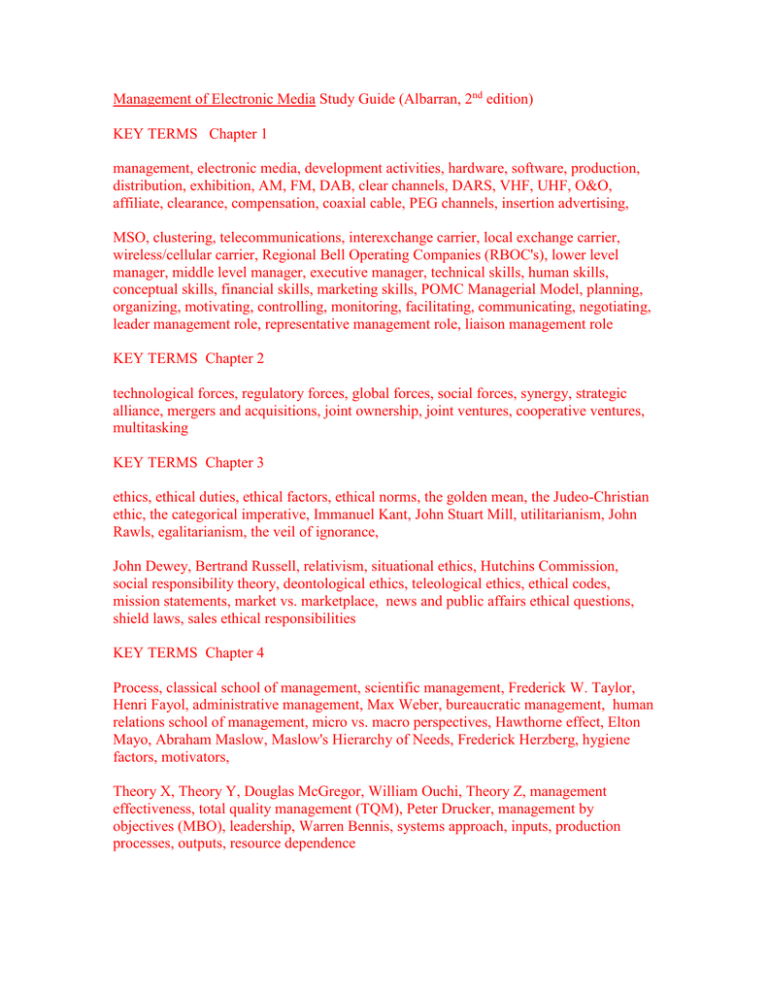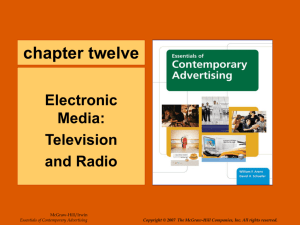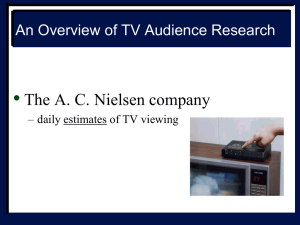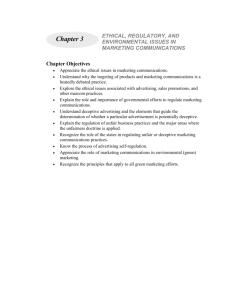Management of Electronic Media Study Guide (Albarran, 2 edition)
advertisement

Management of Electronic Media Study Guide (Albarran, 2nd edition) KEY TERMS Chapter 1 management, electronic media, development activities, hardware, software, production, distribution, exhibition, AM, FM, DAB, clear channels, DARS, VHF, UHF, O&O, affiliate, clearance, compensation, coaxial cable, PEG channels, insertion advertising, MSO, clustering, telecommunications, interexchange carrier, local exchange carrier, wireless/cellular carrier, Regional Bell Operating Companies (RBOC's), lower level manager, middle level manager, executive manager, technical skills, human skills, conceptual skills, financial skills, marketing skills, POMC Managerial Model, planning, organizing, motivating, controlling, monitoring, facilitating, communicating, negotiating, leader management role, representative management role, liaison management role KEY TERMS Chapter 2 technological forces, regulatory forces, global forces, social forces, synergy, strategic alliance, mergers and acquisitions, joint ownership, joint ventures, cooperative ventures, multitasking KEY TERMS Chapter 3 ethics, ethical duties, ethical factors, ethical norms, the golden mean, the Judeo-Christian ethic, the categorical imperative, Immanuel Kant, John Stuart Mill, utilitarianism, John Rawls, egalitarianism, the veil of ignorance, John Dewey, Bertrand Russell, relativism, situational ethics, Hutchins Commission, social responsibility theory, deontological ethics, teleological ethics, ethical codes, mission statements, market vs. marketplace, news and public affairs ethical questions, shield laws, sales ethical responsibilities KEY TERMS Chapter 4 Process, classical school of management, scientific management, Frederick W. Taylor, Henri Fayol, administrative management, Max Weber, bureaucratic management, human relations school of management, micro vs. macro perspectives, Hawthorne effect, Elton Mayo, Abraham Maslow, Maslow's Hierarchy of Needs, Frederick Herzberg, hygiene factors, motivators, Theory X, Theory Y, Douglas McGregor, William Ouchi, Theory Z, management effectiveness, total quality management (TQM), Peter Drucker, management by objectives (MBO), leadership, Warren Bennis, systems approach, inputs, production processes, outputs, resource dependence KEY TERMS Chapter 5 the bottom line, financial management, planning, monitoring, control, capital budgeting, forecasting, postings, balance sheet, assets, liabilities, owner's equity, current assets, fixed assets, goodwill, depreciation, amortization, current liabilities, long-term liabilities, income statement operating statement, profit and loss (P & L) statement, revenues, expenses, cash flow, cash flow multiples, time value of money, present value, net present value, future value of money, compounding, financial ratios, liquidity ratios, debt ratios, capitalization ratios, growth measures, operating income, performance measures, break-even analysis, executive summaries, quarterly reports, annual reports, auditors KEY TERMS Chapter 6 force field analysis, Kurt Lewin, driving forces, restraining forces, personnel manager, means of recruitment, the interview process, the orientation process, unrealistic job preview, performance review, downsizing, outsourcing, termination, equal employment opportunities, sexual harassment, Fair Labor Standards Act, National Labor Relations Act, Equal Employment Act, Age Discrimination in Employment, Equal Pay Act, Americans with Disabilities Act, Family and Medical Leave Act, collective bargaining, mediation, binding arbitration, flow chart, hierarchy, flattening KEY TERMS Chapter 7 target market, target audience, market, dual product market, sweeps, geographic markets, market structure, concentration, concentration ratio, product differentiation, barriers to entry, cost structures, economies of scale, vertical integration, theory of the firm, monopoly, oligopoly, monopolistic competition, perfect competition, regulatory policies, economic conditions, demographic research, psychographic research, geodemographic research, dayparts, VALS, focus groups, call-out research, Nielsen Media Research, Nielsen Peoplemeter, Nielsen families, overnight ratings, The Arbitron Company, diary, Radio's All Dimensional Audience Research (RADAR), industry & trade Associations, consulting firms, internal research departments, rating, rating point, share, Households Using Television (HUT), Persons Using Radio (PUR), Average Quarter-Hour (AQH) persons, AQH rating, AQH share, cume persons, cume rating, exclusive cume rating, Time Spent Listening (TSL), turnover, Designated Market Area (DMA), Metro area, random sampling, nonprobability sample, standard error, confidence interval, Electronic Media Ratings Council (EMRC) KEY TERMS Chapter 8 Program Director, Program Manager, format, niche programming, radio dayparts: morning drive – midday - afternoon drive – evenings, DARS, reverse compensation, first-run syndication, off-network syndication, barter, ad-hoc network, lead-in program strategy, hammocking, tent-poling, counterprogramming, stunting, network television dayparts: early morning – daytime – primetime – late night – overnight, early fringe, late fringe, stacking, cable tiers, V-chip KEY TERMS Chapter 9 The Four Ps: product – price – place – promotion, General Sales Manager (GSM), Local Sales Manager (LSM), National Sales Manager (NSM), Promotions Manager, segmentation, database marketing, positioning, branding, local advertising, account executive (AE), commission, developmental selling, override, inventory, availability, sellout rate, make-good, outsource advertising, national advertising: spot – network, national representative firm (national rep or rep firm), cooperative (co-op) advertising, accruals, gross impressions (GI), gross rating points (GRP), reach, frequency, cost per thousand (CPM), cost per point (CPP), on-air promotion, promos, publicity, sales promotions, community involvement KEY TERMS Chapter 10 Localism, news as programming, News Director, Assistant News Director, Assignments Editor, beat reporting vs. random assignment, Operations Manager, Executive Producer, Producer, Anchor, Reporter, Photographer, Editor, actuality, audience erosion, noncompete clause, sweeps, video news release (VNR) KEY TERMS Chapter 11 executive branch, legislative branch, judicial branch, Radio Act of 1912, Radio Act of 1927, Federal Radio Commission, scarcity principle, PICON principle, Communications Act of 1934, Federal Communications Commission, Telecommunications Act of 1996, deregulation, Fairness Doctrine, ascertainment, fin-syn rules, Mass Media Bureau, Cable Services Bureau, Common Carrier Bureau, ownership limits, duopoly, local marketing agreement (LMA), cross ownership, DTV transition, V-chip, public file, Children's Television Act, obscenity, Miller vs. California (1973), indecency, FCC vs. Pacifica Foundation, Section 315, hoax, lottery, consideration, chance, prize, cable franchise, Cable Television Consumer Protection and Competition Act (1992), must carry, retransmission consent, network exclusivity, syndication exclusivity, PEG channels, rate-of-return (ROR), price cap regulation, public utility commission (PUC), public service commission (PSC), Department of Justice (DOJ), Federal Trade Commission (FTC), National Telecommunications and Information Administration (NTIA), Federal Aviation Administration (FAA), WLBT, citizen standing, NAB Codes KEY TERMS Chapter 12 e-commerce, dot coms, streaming, Intranet, cookies, banner advertising, click-through, B2B, local portals, associate programs




